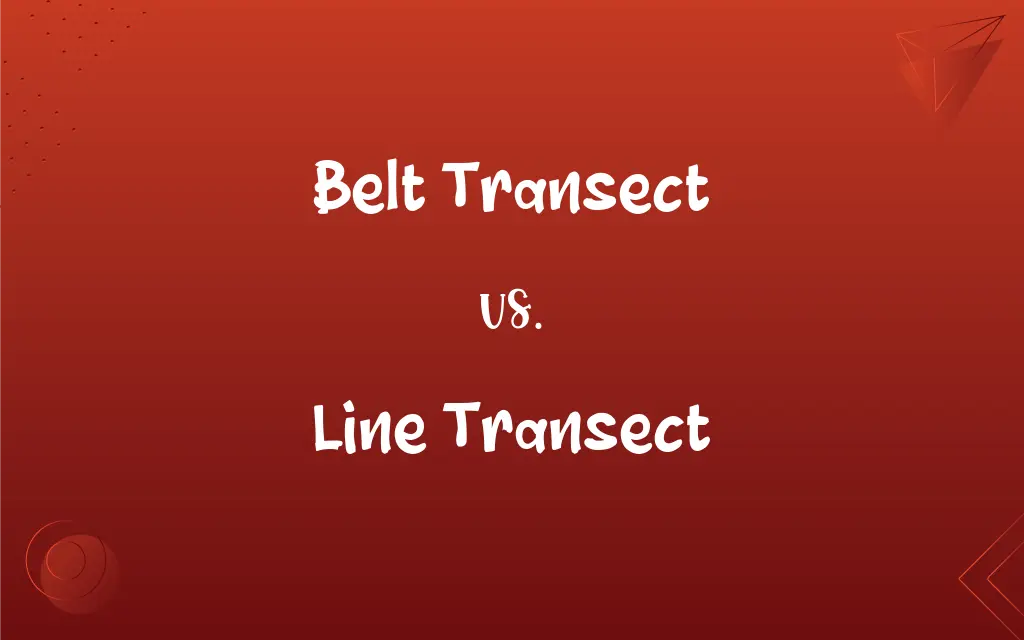Belt Transect vs. Line Transect: What's the Difference?
Edited by Harlon Moss || By Janet White || Published on February 28, 2024
A belt transect involves studying a strip of land for ecological data; a line transect involves observations along a line.

Key Differences
A belt transect is a method used in ecology to study a specific area by examining a strip or 'belt' of land. In contrast, a line transect involves walking along a line and recording observations.
Belt transects cover a wider area, providing a more comprehensive overview of the ecological variation within a strip. Line transects, however, focus on the occurrences along a single line, offering a more linear perspective.
In a belt transect, researchers may examine various layers of an ecosystem, such as ground flora and canopy. Line transects are generally simpler, focusing on the species or elements directly observable along the line.
Belt transects are useful for detailed studies of habitats, including population density and species diversity. Line transects are often used for quick surveys or where minimal disturbance is desired.
Belt transects require more time and resources due to their detailed nature. Line transects, being less resource-intensive, are suitable for larger areas or preliminary surveys.
ADVERTISEMENT
Comparison Chart
Area of Study
Strip or 'belt' of land
Along a single line
Detail
More comprehensive, multi-layer study
Focused, single-layer observation
Usage
Detailed habitat studies
Quick surveys or minimal disturbance
Resources
More time and resource-intensive
Less resource-intensive
Suitability
Population density, species diversity
Larger areas, preliminary surveys
ADVERTISEMENT
Belt Transect and Line Transect Definitions
Belt Transect
Belt transects are used for detailed habitat analysis.
In their study, the belt transect method helped identify various animal habitats.
Line Transect
A line transect involves observations along a straight line in an ecological study.
They used a line transect to count bird species along the trail.
Belt Transect
A belt transect is a method of studying a rectangular area in ecology.
They used a belt transect to assess the forest's biodiversity.
Line Transect
Line transects are suitable for quick ecological surveys.
A quick line transect was used to assess the damage after the storm.
Belt Transect
Belt transects provide comprehensive ecological insights.
Through the belt transect, they discovered new species in the area.
Line Transect
This method is less resource-intensive than belt transects.
For the large park, a line transect was more feasible.
Belt Transect
It involves examining a strip of land for ecological data collection.
The belt transect revealed different vegetation layers in the ecosystem.
Line Transect
It focuses on recording occurrences directly observable along the line.
The line transect showed a gradient in plant species distribution.
Belt Transect
This method covers various ecosystem layers, like flora and fauna.
A belt transect was conducted to understand the canopy structure.
Line Transect
Line transects provide a linear perspective of the studied area.
The line transect revealed a decline in flora near the riverbank.
FAQs
Is a line transect suitable for studying animal populations?
Yes, a line transect is suitable for observing and counting animal populations.
What kind of data does a belt transect provide?
A belt transect provides comprehensive data on species diversity and habitat structure.
What is the main purpose of a belt transect?
A belt transect is used for detailed ecological studies of a specific strip of land.
Are belt transects labor-intensive?
Yes, belt transects are more labor-intensive due to their detailed nature.
How wide is the area studied in a belt transect?
The width of a belt transect can vary but typically covers a few meters on either side of a central line.
How is a line transect conducted?
A line transect is conducted by walking along a line and recording observations.
Are line transects good for initial ecological assessments?
Yes, line transects are ideal for preliminary ecological assessments due to their simplicity.
Can line transects be used in forested areas?
Yes, line transects can be used in forested areas for studying specific ecological aspects.
How long is a typical line transect?
The length of a line transect can vary depending on the study, but it's often several hundred meters.
Can belt transects measure plant biomass?
Yes, belt transects are often used to measure plant biomass and distribution.
How does terrain affect belt transect studies?
Rough terrain can make belt transect studies more challenging due to the need for detailed examination.
Can line transects be used in aquatic environments?
Yes, line transects can be adapted for use in aquatic environments.
How do weather conditions affect line transect surveys?
Adverse weather conditions can impact visibility and accessibility, affecting the accuracy of line transect surveys.
Are line transects effective for bird studies?
Line transects are particularly effective for bird population studies and observations.
How often should belt transects be repeated for accuracy?
The frequency of belt transect repetition depends on the study's objectives, but periodic repetition is recommended for accuracy.
What tools are needed for a belt transect?
Tools for a belt transect include measuring tapes, markers, and data recording sheets or devices.
What skills are required to conduct a belt transect?
Conducting a belt transect requires skills in ecological survey techniques, species identification, and data analysis.
Can line transects be curved?
Typically, line transects are straight, but curved lines can be used to follow natural features.
How is the data from line transects analyzed?
Data from line transects is often analyzed statistically to determine patterns and densities of species.
Can belt transects be used for soil analysis?
Yes, belt transects can include soil sampling and analysis as part of the study.
About Author
Written by
Janet WhiteJanet White has been an esteemed writer and blogger for Difference Wiki. Holding a Master's degree in Science and Medical Journalism from the prestigious Boston University, she has consistently demonstrated her expertise and passion for her field. When she's not immersed in her work, Janet relishes her time exercising, delving into a good book, and cherishing moments with friends and family.
Edited by
Harlon MossHarlon is a seasoned quality moderator and accomplished content writer for Difference Wiki. An alumnus of the prestigious University of California, he earned his degree in Computer Science. Leveraging his academic background, Harlon brings a meticulous and informed perspective to his work, ensuring content accuracy and excellence.































































